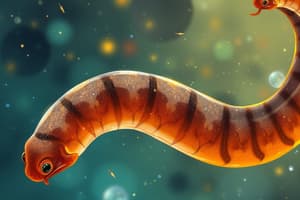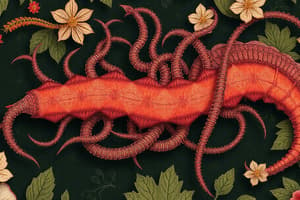Podcast
Questions and Answers
What is one of the key innovations associated with Bilateria organisms?
What is one of the key innovations associated with Bilateria organisms?
- Cephalization (correct)
- Radial symmetry
- Photosynthesis
- Gastrulation
Which symmetry type is NOT appropriate for Bilateria?
Which symmetry type is NOT appropriate for Bilateria?
- Radial symmetry (correct)
- Symmetrical
- Bilateral symmetry
- Asymmetry
Which of the following phyla are included in the Lophotrochozoa group?
Which of the following phyla are included in the Lophotrochozoa group?
- Arthropods and nematodes
- Chordates and echinoderms
- Annelids and molluscs (correct)
- Cnidarians and echinoderms
What is a characteristic feature of Metazoa that allows more complex behavior?
What is a characteristic feature of Metazoa that allows more complex behavior?
What does the term 'bilateral symmetry' imply about an organism?
What does the term 'bilateral symmetry' imply about an organism?
What type of body cavity do organisms in Phylum Platyhelminthes possess?
What type of body cavity do organisms in Phylum Platyhelminthes possess?
Which characteristic is associated with the bilateral symmetry of organisms?
Which characteristic is associated with the bilateral symmetry of organisms?
What type of larvae is specifically associated with organisms in the Lophotrochozoa group?
What type of larvae is specifically associated with organisms in the Lophotrochozoa group?
Which of the following characteristics is indicative of triploblastic organisms?
Which of the following characteristics is indicative of triploblastic organisms?
In which developmental process is the mouth formed from the blastopore?
In which developmental process is the mouth formed from the blastopore?
Which group includes organisms like molluscs and annelids?
Which group includes organisms like molluscs and annelids?
Which of the following organisms are considered diploblastic?
Which of the following organisms are considered diploblastic?
Which type of symmetry is commonly observed in advanced animal forms such as chordates and echinoderms?
Which type of symmetry is commonly observed in advanced animal forms such as chordates and echinoderms?
What is one key characteristic of the phylum Platyhelminthes?
What is one key characteristic of the phylum Platyhelminthes?
What is the primary role of the osmoregulatory system in Platyhelminthes living in freshwater?
What is the primary role of the osmoregulatory system in Platyhelminthes living in freshwater?
What type of waste products do Platyhelminthes primarily excrete through diffusion?
What type of waste products do Platyhelminthes primarily excrete through diffusion?
Which of the following is a function of lamellate rhabdites in Platyhelminthes?
Which of the following is a function of lamellate rhabdites in Platyhelminthes?
What type of symmetry do Platyhelminthes exhibit?
What type of symmetry do Platyhelminthes exhibit?
What is the significance of cephalization in Platyhelminthes?
What is the significance of cephalization in Platyhelminthes?
What structure caps the protonephridia in Platyhelminthes?
What structure caps the protonephridia in Platyhelminthes?
What is the secondary role of the protonephridial system in Platyhelminthes?
What is the secondary role of the protonephridial system in Platyhelminthes?
What is the primary role of proglottids in the strobila of a tapeworm?
What is the primary role of proglottids in the strobila of a tapeworm?
What is a common method of reproduction observed in tapeworms?
What is a common method of reproduction observed in tapeworms?
How does a tapeworm like Taenia saginata obtain nutrients?
How does a tapeworm like Taenia saginata obtain nutrients?
What condition can result from humans becoming intermediate hosts for Taenia solium?
What condition can result from humans becoming intermediate hosts for Taenia solium?
Which of the following best describes the role of the definitive host in the life cycle of Taenia saginata?
Which of the following best describes the role of the definitive host in the life cycle of Taenia saginata?
What significant damage can cysticerci cause when they infect the human body?
What significant damage can cysticerci cause when they infect the human body?
What type of reproductive method is considered rare among tapeworms?
What type of reproductive method is considered rare among tapeworms?
In what stage does the shelled larva of Taenia saginata begin its development within the cow?
In what stage does the shelled larva of Taenia saginata begin its development within the cow?
What is the main characteristic of the reproductive system in Platyhelminthes?
What is the main characteristic of the reproductive system in Platyhelminthes?
Which of the following classes of Platyhelminthes is known for being endoparasitic?
Which of the following classes of Platyhelminthes is known for being endoparasitic?
What type of life cycle do Neodermata often exhibit?
What type of life cycle do Neodermata often exhibit?
How do flatworms in the Grade Turbellaria typically move?
How do flatworms in the Grade Turbellaria typically move?
Which structure is NOT commonly found in the epidermis of higher Platyhelminthes?
Which structure is NOT commonly found in the epidermis of higher Platyhelminthes?
What is a distinguishing feature of Class Cestoda?
What is a distinguishing feature of Class Cestoda?
Which type of reproduction is predominant in Grade Turbellaria?
Which type of reproduction is predominant in Grade Turbellaria?
In endoparasites belonging to the class Trematoda, what is the significance of the anterior adhesive organ?
In endoparasites belonging to the class Trematoda, what is the significance of the anterior adhesive organ?
What method of respiration do Platyhelminthes primarily utilize?
What method of respiration do Platyhelminthes primarily utilize?
Which characteristic is TRUE regarding the gut of Platyhelminthes?
Which characteristic is TRUE regarding the gut of Platyhelminthes?
Which feature distinguishes the nervous system of Platyhelminthes?
Which feature distinguishes the nervous system of Platyhelminthes?
In the life cycle of Clonorchis sinensis, what is the role of the definitive host?
In the life cycle of Clonorchis sinensis, what is the role of the definitive host?
Which of the following adaptations is NOT found in endoparasitic Platyhelminthes?
Which of the following adaptations is NOT found in endoparasitic Platyhelminthes?
What common feature is found in all classes of Platyhelminthes?
What common feature is found in all classes of Platyhelminthes?
Flashcards are hidden until you start studying
Study Notes
Phylum Platyhelminthes
- Acoelomate: body cavity filled with parenchyma
- Muscle cells and parenchyma derived from mesoderm
- Triploblastic
- Lophotrochozoa
- 20-30K species
- Marine, freshwater, and terrestrial
- Many endoparasites
Flatworm Features
- Great surface area to volume ratio
- Appropriate for gas exchange, nutrition, and waste management
- Synapomorphy: lamellate rhabdites, rod-shaped structures that swell when discharged in water to form a mucus coating
- Role in locomotion and gas exchange
New features of Flatworms
- Excretory/osmoregulatory system
- Copulatory organs
- Cephalization
- Central nervous system
Excretory/Osmoregulatory System
- Excretion: elimination of metabolic waste products
- Osmoregulation: maintenance of stable internal solutes concentrations, regulation of total amount of solutes in a solution
- In sponges and cnidarians, these processes are mainly at the cellular level
- Most bilaterally symmetrical animals need a system to collect metabolic waste and/or regulate the amount of water in tissues
- Protonephridia: network of tubules capped by flame cells inside and opening outside by a nephridiopore
- Protonephridia's primary role: remove excess water, especially in freshwater
- Protonephridia's secondary role: excretion of ammonia
Central Nervous System
- Cephalization: sensory reception, ocelli and chemoreceptors on the head
Copulation
- Direct contact between two individuals to transfer sperm
- Internal fertilization
Reproductive System
- Platyhelminthes are monoecious
Physiology
- Respiratory system: diffusion through body surface
- Mucus = humid (terrestrial organisms)
- Skeletal system: muscles and parenchyma
- Circulatory system: none, surface area optimized for many systems
Four Groups of Flatworms
- Turbellaria grade (flatworms)
- Class Trematoda (flukes)
- Class Cestoda (tapeworms)
Grade Turbellaria (Flatworms)
- Mostly free-living scavengers and predators
- 50-500mm
- NOT parasites
- Typically creep along substrate using mucus and ventral cilia
- Epidermis: formed by rhabdite cells and cilia
Grade Turbellaria, Digestive and Nervous Systems
- No anus
- Cephalization
- Primitive CNS
- Sensory reception: ocelli and chemoreceptors on the head
Grade Turbellaria, Reproduction and Life Cycle
- Sexual reproduction: monoecious, usually practice cross-fertilization
- Asexual reproduction: fission, fragmentation, and regeneration
- Simple life cycle with direct development (immature instead of larva)
Clade Neodermata
- All endoparasites
- Complex life cycles
- Requires specific sequences of two or more hosts to complete the lifecycle
- Intermediate host: worms are immature, no sexual reproduction, asexual reproduction in some species
- Definitive host: worms are mature adults, sexual reproduction
Clade Neodermata, Adaptations
- Penetration glands
- Hooks
- Increased reproductive capacity
- Epidermis: NOT ciliated, loss of rhabdites, syncytial tegument
Class Trematoda (Flukes)
- Leaf-like form, relatively similar to turbellarians
- All endoparasites
- Socio-economically devastating parasites
- Body design reflects adaptations to parasitism
- Life cycle involves both sexual and asexual reproduction
- Anterior adhesive organ: suckers and hooks
Class Cestoda (Tapeworms)
- All endoparasites, adults infect vertebrates' gut
- Syncytial tegument (like trematodes)
- Intermediate hosts: vertebrates or invertebrates
- Monoecious
- Some very large, over 8 meters long
- Basic body plan: scolex, attachment device (suckers and hooks), NOT head! Strobila: continuous growth behind scolex, made of many proglottids
Class Cestoda: Proglottids and Digestion
- Each proglottid is fully reproductive
- Self-fertilization is common
- No mouth, no digestive system
- How do they feed? tegument
Studying That Suits You
Use AI to generate personalized quizzes and flashcards to suit your learning preferences.




